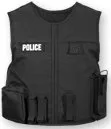Body Armour Is A Life Saver
These days, body armour vests are nearly as common among law enforcement officers as badges and guns.
Though the widespread use of body armour vests has been credited with saving more than 3,000 lives since the 1980s, there are limits. Even when wearing protective gear, officers sometimes die at the hands of gun-wielding suspects.
It’s unclear what role body armour vests played in the shooting deaths Monday of two St. Petersburg police officers, both of whom were wearing body armour vests.
Sgt. Thomas J. Baitinger was shot at least once in an upper torso area not covered by his vest. Officer Jeffrey A. Yaslowitz’s fatal injuries haven’t been specified.
A supervisor of the deputy U.S. marshal who was wounded says his colleague’s vest saved his life by stopping a bullet from penetrating his upper torso. Still, a second shot hit him in the lower abdomen below his armor.
Body armour vests save lives and should be used by officers every day, said John Firman, director of research for the International Association of Chiefs of Police. “The technology has gotten much lighter and the design is much better,” he said.
Not all officers wear armor. A 2009 study for the U.S. Department of Justice shows that almost all departments responding to a survey issue body armour vests, but only 59 percent require it be used.
Though military use of body armor dates back centuries, it wasn’t introduced to law enforcement until the 1970s. Those early, bulky vests were unpopular. The government, through the National Institute of Justice, created standards that increased safety. Manufacturers invented body armor materials that made vests less cumbersome.
At the Tampa Police Department, officers can choose among vests made by four body armor manufacturers based on preference and fit, a spokeswoman said Wednesday. All meet government standards.
Body armour vests only stand up to certain calibers
Wayne State University biomedical engineering professor Cynthia Bir has studied law enforcement injuries and body armour vests for more than a decade. She said there are generally two reasons why officers wearing body armour vests meet tragedy: either the bullet hits an unprotected area of the body, or the vest wasn’t designed to stand up to the caliber of weapon fired. “As long as it’s not an overmatched threat, as long as it’s a bullet that the vest is rated to stop, we haven’t had any issues with having any severe or fatal injuries,” she said.
The debate about how much of officers’ bodies should be covered is complicated, Firman said.
SWAT teams and other tactical units usually wear vests that give the maximum level of protection, cover high on the chest and extend low on the abdomen.
But such armor is impractical for routine use. “The problem that we face is, you get to a stage where you cannot limit the mobility of the officer,” Firman said.








